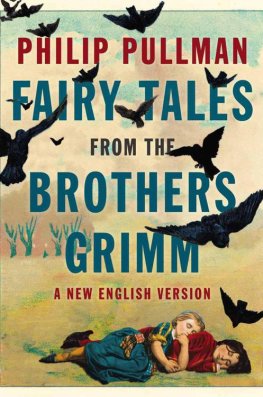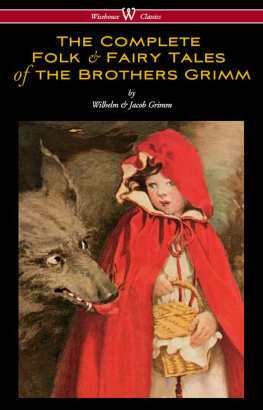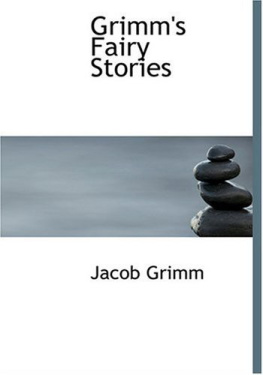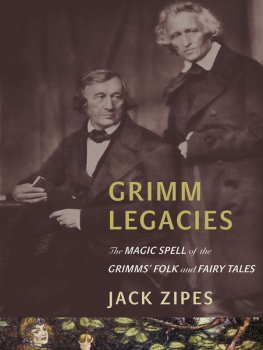Brothers Grimm - The Complete Grimms Fairy Tales
Here you can read online Brothers Grimm - The Complete Grimms Fairy Tales full text of the book (entire story) in english for free. Download pdf and epub, get meaning, cover and reviews about this ebook. year: 1972, publisher: Pantheon, genre: Art. Description of the work, (preface) as well as reviews are available. Best literature library LitArk.com created for fans of good reading and offers a wide selection of genres:
Romance novel
Science fiction
Adventure
Detective
Science
History
Home and family
Prose
Art
Politics
Computer
Non-fiction
Religion
Business
Children
Humor
Choose a favorite category and find really read worthwhile books. Enjoy immersion in the world of imagination, feel the emotions of the characters or learn something new for yourself, make an fascinating discovery.

- Book:The Complete Grimms Fairy Tales
- Author:
- Publisher:Pantheon
- Genre:
- Year:1972
- Rating:3 / 5
- Favourites:Add to favourites
- Your mark:
- 60
- 1
- 2
- 3
- 4
- 5
The Complete Grimms Fairy Tales: summary, description and annotation
We offer to read an annotation, description, summary or preface (depends on what the author of the book "The Complete Grimms Fairy Tales" wrote himself). If you haven't found the necessary information about the book — write in the comments, we will try to find it.
The Complete Grimms Fairy Tales — read online for free the complete book (whole text) full work
Below is the text of the book, divided by pages. System saving the place of the last page read, allows you to conveniently read the book "The Complete Grimms Fairy Tales" online for free, without having to search again every time where you left off. Put a bookmark, and you can go to the page where you finished reading at any time.
Font size:
Interval:
Bookmark:
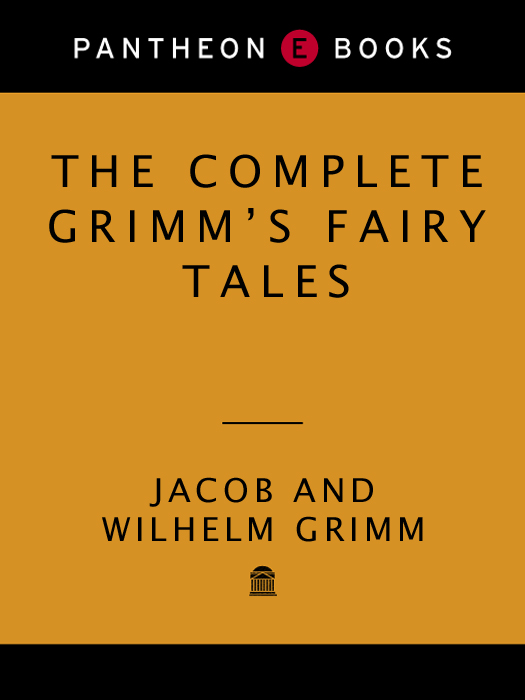
INTRODUCTION BY PADRAIC COLUM
FOLKLORISTIC COMMENTARY BY
JOSEPH CAMPBELL
212 ILLUSTRATIONS BY JOSEF SCHARL
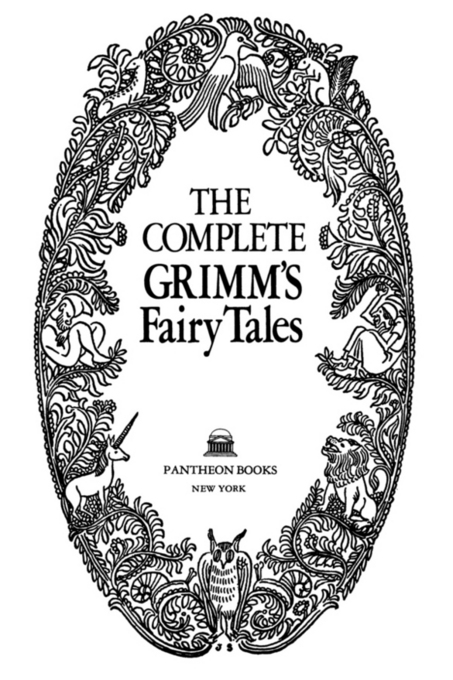
Copyright 1944 by Pantheon Books Inc.
Copyright renewed 1972 by Random House, Inc.
All rights reserved. Published in the United States by Pantheon Books, a division of Random House, Inc., New York, and in Canada by Random House of Canada Limited, Toronto.
eISBN: 978-0-307-79718-6
The text of this edition is based on the translation by Margaret Hunt. It has been thoroughly revised, corrected and completed by James Stern.
www.pantheonbooks.com
v3.1
I N THE place where the storyteller was the coming of night was marked as it was not in towns nor in modern houses. It was so marked that it created in the mind a different rhythm. There had been a rhythm of the day and now there was a rhythm of the night. The storyteller seated on a roughly made chair on a clay floor did not look unusually intelligent or sensitive. He certainly did not look histrionic. What was in his face showed that he was ready to respond to and make articulate the rhythm of the night. He was a storyteller because he was attuned to this rhythm and had in his memory the often repeated incidents that would fit it. These notions were in the present writers mind once upon a time when he sat in a cottage where the traditon of storytelling was still in being.
A rhythm that was compulsive, fitted to daily tasks, waned, and a rhythm that was acquiescent, fitted to wishes, took its place. But when the distinction between day and night could be passed over as it could be in towns and in modern houses the change of rhythm that came with the passing of day into night ceased to be marked. This happened when light was prolonged until it was time to turn to sleep.
The prolongation of light meant the cessation of traditional stories in European cottages. And when the cottages took in American kerosene or paraffin there was prolongation. Then came lamps with full and steady light, lamps that gave real illumination. Told under this illumination the traditional stories ceased to be appropriate because the rhythm that gave them meaning was weakened.
Other things happened to put traditional stories out of date. Young people went to schools and learned to read. The world reached into the villages; wars and the doings of congresses interested country people more and more. Claiming attention for the happenings of the day before, the newspaper reader took the place of the traditional storyteller, the man of memories.
A real culture, we know, is all of a piece and all its parts fit together. Household stories imply work done in a household and work done in a household implies household stories. In western Ireland today a loom or a spinning-wheel is a sign that one can find a traditional storyteller in the cottage or in the neighborhood. The present writer has heard from his elders that in times when the girls of the neighborhood came to a cottage to do the spinning a storyteller was fetched to entertain them. Men and women coming in from factories would not be entertained by household stories but people who worked in the house would. The prolongation of light, the introduction of books and newspapers, the cessation of the household arts all went together to make an end of traditional stories in European cottages.
There were other reasons. A widespread language took the place of dialects and the language of the traditional stories became obscure. The meaning of the stories could only be put baldy into the widespread language; the current language was not traditional enough to relate the traditions in. In High German, the Brothers Grimm noted, a story gained in clearness (that is, clearness for the reader), but it lost in flavor, and no longer had such a firm hold of the kernel of the thing signified. They were wise enough not to put all their collection in High German; frequently they retained the dialect of the district where they heard the stories.
Today we can hear traditional stories but in very out-of-the-way parts of Europe. A writer who lived in such places gives us a sense of distance from the modern world when he puts a storytelling session before us. He is so blind that I can gaze at him without discourtesy, and after a while the expression of his face made me forget to listen. The glow of childish transport that came over him when he reached the nonsense endingso common in these talesrecalled me to myself, and I listened attentively while he gabbled
The Brothers Grimm tell us about one who at the beginning of the nineteenth century gave them their best stories, a woman from near Kassel. Her memory kept a firm grip on all the sagas. She herself knew that this gift was not granted to everyone, and that there were many who could remember nothing connectedly. She told her stories thoughtfully, accurately, with wonderful vividness, and evidently had delight in doing it. First, she related them from beginning to end, and then, if required, repeated them more slowly, so that after some practice, it was perfectly easy to write from her dictation. Very likely, because they had to write down her words, the Brothers Grimm laid stress upon this storytellers verbal memory; others in listening to her might have thought that her real gift was perception of pattern, and her real accomplishment making it, the pattern, evident.
There were those who could remember nothing connectedly. We might say that they were the mediocre storytellers who confused the pattern by putting incidents in the wrong place, by using unfitting metaphors, by making a hurried beginning or a hurried end, by being unable to use the chiming words that made specialor, as we would say now, that featured some passage: puddle with path, tooth with lose, for example.
The rhythm of night, marked in the place where it was told, set the mood without which the traditional story would have diminished appeal. The household arts there were unvarying from generation to generation, and so were the patterns of the stories. One did not introduce new designs into weaving or cart-building, and one did not introduce new designs into storytelling. We have been told that the hearers of traditional stories wanted to have remembered incidents, remembered sentences, repeated. But the unvarying content of a story was not altogether due to a liking for the same thing over again. The good traditional storyteller had a sense of pattern and prided himself or herself on knowing and keeping to it.
Because they had few possessions and these transmitted to them, or made by their own hands or the hands of people they knew, the tellers and hearers of these stories valued things, visible, tangible, usable things. They put a thing in the center of the story and it gave a pattern. What an advantage it is to a storyteller to have a feeling for the value, for the uniqueness of a thing! Things remain real while mental states become doubtful to us.
The golden slipper on the stairway is what the incidents in Cinderella lead up to and lead away from. And the gold of the slipper puts into greater obscurity the drably dressed girl crouched by the ashes. In Snow White there is the looking glass of the wicked queen which is doubled in the glass coffin in which Snow White is laid by the kindly dwarfs. In Briar Rose there is the spindle that is doubled in the thorns that hedge the castle. In The Goose Girl the horses head that speaks is doubled in the hat the wind blows away, and in King Thrushbeard the crockery which the kings daughter has to sell is doubled in the jars which, as the kitchen maid, she uses to bring the dinner leavings home, and which break, too. These correspondences are like rhymes which chance gives a poet and which, duly set down, gives his poem a happy completeness. Another kind of correspondence is in Rapunzel: the maiden has long hair and the witch confines her in a tower, and we do not know whether the tower makes it proper she should have long hair, or whether her long hair makes the tower part of the story.
Font size:
Interval:
Bookmark:
Similar books «The Complete Grimms Fairy Tales»
Look at similar books to The Complete Grimms Fairy Tales. We have selected literature similar in name and meaning in the hope of providing readers with more options to find new, interesting, not yet read works.
Discussion, reviews of the book The Complete Grimms Fairy Tales and just readers' own opinions. Leave your comments, write what you think about the work, its meaning or the main characters. Specify what exactly you liked and what you didn't like, and why you think so.



